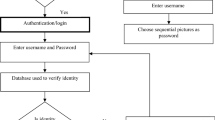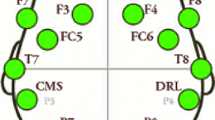Abstract
The response of the P300-based speller is associated with factors like matrix size, inter-stimulus interval, and flashing period. This study proposes the comparison of the novel 2 × 2 image-based speller with the traditional 6 × 6 character-based speller to analyze the effects of the stimulus on the accuracy and information transfer rates. To determine the best classification methodology for the approach suggested, a comparative study was performed using linear and quadratic discrimination analysis, K-nearest neighbor, and support vector machine. In the proposed paradigm, four pictures (objects, special symbols, geometrical shapes, and colors) were randomly placed at four corners of the monitor. Subjects were asked to focus on the target image while ignoring all other images. The proposed method outperformed the traditional method, with an average accuracy of 96.99 ± 1.64% and 86.74 ± 5.19%, respectively, and information transfer rates of 33.82 ± 0.57 bits/min and 23.35 ± 0.79 bits/min, respectively. Results show that a modified speller can play a significant role in optimizing brain-computer interface-driven applications. A repeated measure ANOVA test was performed, which concluded that the improved results are obtained using QDA classifiers in terms of mean accuracy, speed, and error rates.
Graphical abstract










Similar content being viewed by others
Abbreviations
- BCI:
-
Brain-computer interface
- SSVEP:
-
Steady-state visual evoked potential
- LDA:
-
Linear discriminant analysis
- FRR :
-
False rejection rate
- FAR:
-
False acceptance rate
- ERP:
-
Event-related potential
- QDA:
-
Quadratic discriminant analysis
- ITR:
-
Information transfer rate
References
O’Gorman L (2003) Comparing passwords, tokens, and biometrics for user authentication. Proc IEEE 91:2021–2040
Shanmugapriya D, Padmavathi G (2009) A survey of biometric keystroke dynamics: approaches, security and challenges. arXiv Prepr arXiv09100817
Saifan R, Salem A, Zaidan D, Swidan A (2016) A Survey of behavioral authentication using keystroke dynamics: Touch screens and mobile devices. J Soc Sci 5:29–41
Wanjau SK, Wambugu GM, Kamau GN (2021) SSH-brute force attack detection model based on deep learning
Ghogare SD, Jadhav SP, Chadha AR, Patil HC (2012) Location based authentication: a new approach towards providing security. Int J Sci Res Publ 2:1–5
Kaliraman B, Singh P, Duhan M (2021) Use of EEG as a unique human biometric trait for authentication of an individual. In: Advances in Communication and Computational Technology. Springer, pp 277–286
Atum Y, Pacheco M, Acevedo R et al (2019) A comparison of subject-dependent and subject-independent channel selection strategies for single-trial P300 brain computer interfaces. Med Biol Eng Comput. https://doi.org/10.1007/s11517-019-02065-z
Xu M, Xiao X, Wang Y et al (2018) A brain–computer interface based on miniature-event-related potentials induced by very small lateral visual stimuli. IEEE Trans Biomed Eng 65:1166–1175
Ahirwal MK, Londhe ND (2012) Power spectrum analysis of EEG signals for estimating visual attention. Int J Comput Appl 42:22–25
Wolpaw JR, Birbaumer N, McFarland DJ et al (2002) Brain–computer interfaces for communication and control. Clin Neurophysiol 113:767–791
Scherer R, Muller GR, Neuper C et al (2004) An asynchronously controlled EEG-based virtual keyboard: improvement of the spelling rate. IEEE Trans Biomed Eng 51:979–984
Hosni SM, Shedeed HA, Mabrouk MS, Tolba MF (2019) EEG-EOG based virtual keyboard: toward hybrid brain computer interface. Neuroinformatics
Zheng M, Yang B, Xie Y (2020) EEG classification across sessions and across subjects through transfer learning in motor imagery-based brain-machine interface system. Med Biol Eng Comput. https://doi.org/10.1007/s11517-020-02176-y
Vaughan TM, Heetderks WJ, Trejo LJ, et al (2003) Brain-computer interface technology: a review of the Second International Meeting.
Kong W, Guo S, Long Y, et al (2018) Weighted extreme learning machine for P300 detection with application to brain computer interface. J Ambient Intell Humaniz Comput 1–11
Zúquete A, Quintela B, da Silva Cunha JP (2010) Biometric authentication using brain responses to visual stimuli. In: Biosignals. pp 103–112
Kaiser J, Walker F, Leiberg S, Lutzenberger W (2005) Cortical oscillatory activity during spatial echoic memory. Eur J Neurosci 21:587–590
Birbaumer N (2006) Breaking the silence: brain–computer interfaces (BCI) for communication and motor control. Psychophysiology 43:517–532
Shukla PK, Chaurasiya RK, Verma S (2021) Performance improvement of P300-based home appliances control classification using convolution neural network. Biomed Signal Process Control. https://doi.org/10.1016/j.bspc.2020.102220
Mary Judith A, Baghavathi Priya S Multiset task related component analysis (M-TRCA) for SSVEP frequency recognition in BCI. J Ambient Intell Humaniz Comput 1–10
Mohanchandra K, Saha S, Lingaraju GM (2015) EEG based brain computer interface for speech communication: principles and applications. In: Brain-Computer Interfaces. Springer, pp 273–293
Cecotti H (2011) Spelling with non-invasive brain–computer interfaces–current and future trends. J Physiol 105:106–114
Rak RJ, Kołodziej M, Majkowski A (2012) Brain-computer interface as measurement and control system the review paper. Metrol Meas Syst 19:427–444
Nicolas-Alonso LF, Gomez-Gil J (2012) Brain computer interfaces a review. Sensors 12:1211–1279
Ramadan RA, Vasilakos AV (2017) Brain computer interface: control signals review. Neurocomputing 223:26–44
Farwell LA, Donchin E (1988) Talking off the top of your head: toward a mental prosthesis utilizing event-related brain potentials. Electroencephalogr Clin Neurophysiol 70:510–523
Cipresso P, Carelli L, Solca F et al (2012) The use of P300-based BCIs in amyotrophic lateral sclerosis: from augmentative and alternative communication to cognitive assessment. Brain Behav 2:479–498
Allison BZ, Pineda JA (2003) ERPs evoked by different matrix sizes: implications for a brain computer interface (BCI) system. IEEE Trans neural Syst Rehabil Eng 11:110–113
Salvaris M, Sepulveda F (2009) Visual modifications on the P300 speller BCI paradigm. J Neural Eng 6:46011
Takano K, Komatsu T, Hata N et al (2009) Visual stimuli for the P300 brain–computer interface: a comparison of white/gray and green/blue flicker matrices. Clin Neurophysiol 120:1562–1566
Mu Z, Hu J, Min J (2016) EEG-based person authentication using a fuzzy entropy-related approach with two electrodes. Entropy 18:432
Sellers EW, Donchin E (2006) A P300-based brain–computer interface: initial tests by ALS patients. Clin Neurophysiol 117:538–548
Piccione F, Giorgi F, Tonin P et al (2006) P300-based brain computer interface: reliability and performance in healthy and paralysed participants. Clin Neurophysiol 117:531–537
Donchin E, Spencer KM, Wijesinghe R (2000) The mental prosthesis: assessing the speed of a P300-based brain-computer interface. IEEE Trans Rehabil Eng 8:174–179
Rakotomamonjy A, Guigue V (2008) BCI competition III: dataset II-ensemble of SVMs for BCI P300 speller. IEEE Trans Biomed Eng 55:1147–1154
Ajufor N, Amalraj A, Diaz R et al (2008) Refinement of a mouse movement biometric system. Pace Univ, Proc CSIS Res Day
Everitt RAJ, McOwan PW (2003) Java-based internet biometric authentication system. IEEE Trans Pattern Anal Mach Intell 25:1166–1172
Farquhar J, Hill NJ (2013) Interactions between pre-processing and classification methods for event-related-potential classification: best-practice guidelines for brain-computer interfacing. Neuroinformatics. https://doi.org/10.1007/s12021-012-9171-0
Zhou Z, Yin E, Liu Y et al (2014) A novel task-oriented optimal design for P300-based brain–computer interfaces. J Neural Eng 11:56003
Xu M, Han J, Wang Y et al (2020) Implementing over 100 command codes for a high-speed hybrid brain-computer interface using concurrent P300 and SSVEP features. IEEE Trans Biomed Eng 67:3073–3082
Ille N, Berg P, Scherg M (2002) Artifact correction of the ongoing EEG using spatial filters based on artifact and brain signal topographies. Clin Neurophysiol 19:113–124. https://doi.org/10.1097/00004691-200203000-00002
Townsend G, LaPallo BK, Boulay CB et al (2010) A novel P300-based brain–computer interface stimulus presentation paradigm: moving beyond rows and columns. Clin Neurophysiol 121:1109–1120
Picton TW (1992) The P300 wave of the human event-related potential. J Clin Neurophysiol 9:456–479
Kaongoen N, Yu M, Jo S (2017) Two-factor authentication system using P300 response to a sequence of human photographs. IEEE Trans Syst Man, Cybern Syst
Vanek J, Moucek R (2018) Deep learning techniques for classification of P300 Component. In: HEALTHINF. pp 446–453
Krusienski DJ, Sellers EW, Cabestaing F et al (2006) A comparison of classification techniques for the P300 Speller. J Neural Eng 3:299
Panicker RC, Puthusserypady S, Sun Y (2010) Adaptation in P300 brain–computer interfaces: a two-classifier cotraining approach. IEEE Trans Biomed Eng 57:2927–2935
Thulasidas M, Guan C, Wu J (2006) Robust classification of EEG signal for brain-computer interface. IEEE Trans Neural Syst Rehabil Eng 14:24–29
Kundu S, Ari S (2018) P300 detection with brain–computer interface application using PCA and ensemble of weighted SVMs. IETE J Res 64:406–414
Krusienski DJ, Sellers EW, McFarland DJ et al (2008) Toward enhanced P300 speller performance. J Neurosci Methods 167:15–21
Alsberg BK, Goodacre R, Rowland JJ, Kell DB (1997) Classification of pyrolysis mass spectra by fuzzy multivariate rule induction-comparison with regression, K-nearest neighbour, neural and decision-tree methods. Anal Chim Acta 348:389–407
Pierce JR (2012) An introduction to information theory: symbols, signals and noise. Courier Corporation
Sundaram M, Mani A (2016) Face recognition: demystification of multifarious aspect in evaluation metrics. In: Face Recognition - Semisupervised Classification, Subspace Projection and Evaluation Methods
Sellers EW, Krusienski DJ, McFarland DJ et al (2006) A P300 event-related potential brain–computer interface (BCI): the effects of matrix size and inter stimulus interval on performance. Biol Psychol 73:242–252
Duncan-Johnson CC, Donchin E (1977) On quantifying surprise: the variation of event-related potentials with subjective probability. Psychophysiology 14:456–467
Meinicke P, Kaper M, Hoppe F, et al Improving transfer rates in brain computer interface: a case study. 2002. In: Neural Information Processing Systems. pp 1107–1114
Hoffmann U, Vesin J-M, Ebrahimi T, Diserens K (2008) An efficient P300-based brain–computer interface for disabled subjects. J Neurosci Methods 167:115–125
Serby H, Yom-Tov E, Inbar GF (2005) An improved P300-based brain-computer interface. IEEE Trans neural Syst Rehabil Eng 13:89–98
Ludwig SA, Kong J (2017) Investigation of different classifiers and channel configurations of a mobile P300-based brain–computer interface. Med Biol Eng Comput 55:2143–2154
Li F, Li X, Wang F et al (2020) A novel P300 classification algorithm based on a principal component analysis-convolutional neural network. Appl Sci 10:1546
Salimi-Khorshidi G, Nasrabadi AM, Golpayegani MH (2008) Fusion of classic P300 detection methods’ inferences in a framework of fuzzy labels. Artif Intell Med 44:247–259
Oweis RJ, Hamdi N, Ghazali A, Lwissy K (2013) A comparison study on machine learning algorithms utilized in P300-based BCI. J Heal Med Informat 4:2
Mirghasemi H, Fazel-Rezai R, Shamsollahi MB (2006) Analysis of P300 classifiers in brain computer interface speller. In: 2006 International Conference of the IEEE Engineering in Medicine and Biology Society. IEEE, pp 6205–6208
Acknowledgements
The authors thank the participants for their active participation in this experiment.
Author information
Authors and Affiliations
Corresponding author
Ethics declarations
Ethics approval and consent
Experiments on human subjects were performed with the prior consent of the Institute’s ethics committee.
Competing interests
The authors declare no competing interests.
Additional information
Publisher's note
Springer Nature remains neutral with regard to jurisdictional claims in published maps and institutional affiliations.
Rights and permissions
Springer Nature or its licensor holds exclusive rights to this article under a publishing agreement with the author(s) or other rightsholder(s); author self-archiving of the accepted manuscript version of this article is solely governed by the terms of such publishing agreement and applicable law.
About this article
Cite this article
Rathi, N., Singla, R. & Tiwari, S. A comparative study of classification methods for designing a pictorial P300-based authentication system. Med Biol Eng Comput 60, 2899–2916 (2022). https://doi.org/10.1007/s11517-022-02626-9
Received:
Accepted:
Published:
Issue Date:
DOI: https://doi.org/10.1007/s11517-022-02626-9




